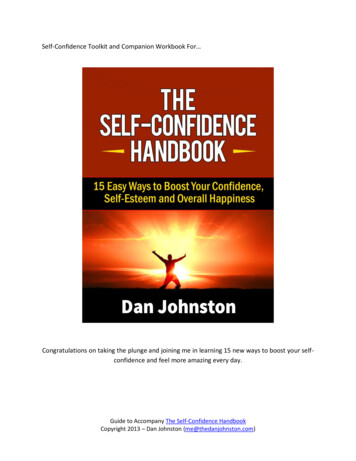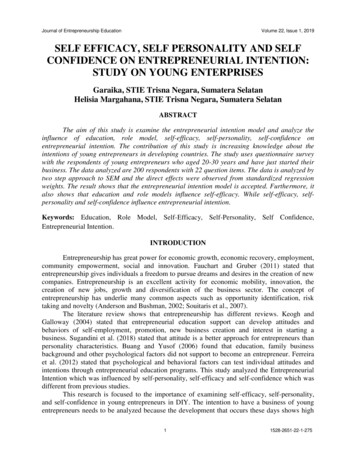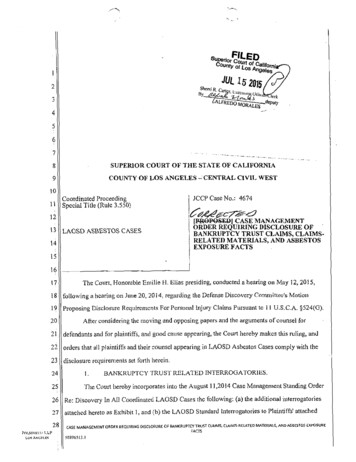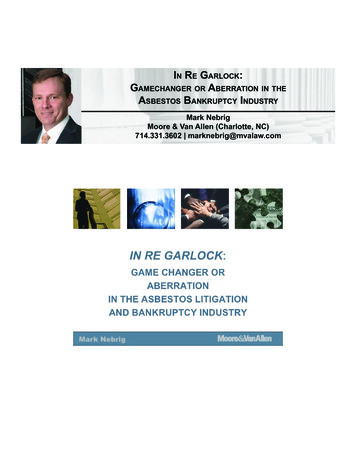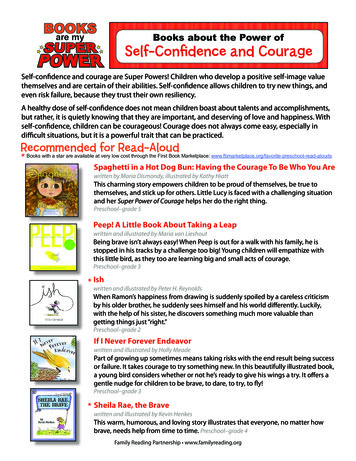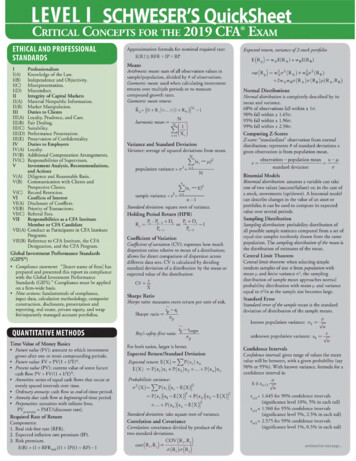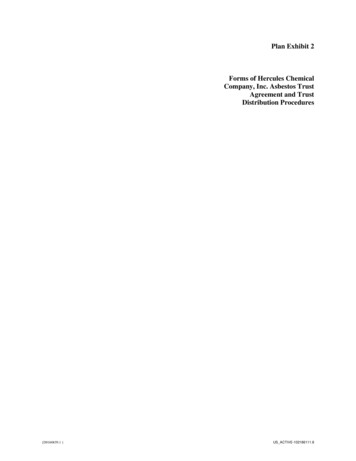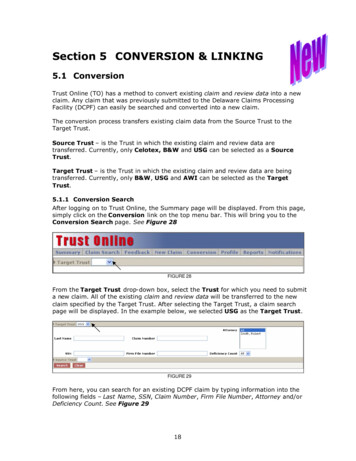
Transcription
Self-trust and self-confidence: some distinctionsLloyd J. CarrPhilosophy DepartmentRivier UniversityNashua, NH 03060lcarr@rivier.eduWebsite: http://www.rivier.edu/faculty/lcarr1. Introduction: framework and assumptionsRelations imply relata, and so interpersonal relationships require distinct persons, at least two, amongwhom they hold. One person, for example, might come to the aid of, befriend, joke with, deceive,bargain with, trust, take interest in or respect another person, or one person might have any of theserelationships to several other persons who might or might not reciprocate. Similarly, interagentialrelations require distinct agents, at least two, among which they hold; for example, two chess programsmight creatively play each other, or a human and Watson might compete at the game Jeopardy, orhuman passengers might trust (or distrust) their plane’s automatic pilot, or a family might benefit frombeing driven somewhere by a self-driving smart-car or living in a smart-house that recognizes and serveseach individual inhabitant. For interpersonal and interagential relations, it is generally the nature of therelation that is questioned; it is clear who or what the two or more required relata are.The same requirement exists for intrapersonal relations but in this case the relata, again at least two,are not as obvious as they are in the case of interpersonal or interagential relationships. Self-esteem,self-respect, self-acceptance, self-control, self-doubt, self-deception, self-confidence, self-trust,bargaining with oneself, being one’s own worst enemy, and self-denial, for example, are thought to bedeeply human possibilities, yet there is no clear agreement about who or what forms the termsbetween which these relations hold. Philosophers who work in the area of intrapersonal relations havedevised two strategies for dividing one person into the required multiplicity such that these are (i)sufficiently diverse for these kinds of self-relations to hold, yet (ii) sufficiently unified to constitute oneperson – a single self. A problem, of course, is equally satisfying both conditions (but that’s anotherstory).One strategy, Humean in spirit if not by direct influence, is to conceive a person as an aggregate ofinterests, each a coherent assembly of epistemic and practical abilities and accomplishments; each richenough to be considered a kind of “sub-self” having its projects, goals, duties and “life.” Some of theseinterests conflict while others are mutually supportive; some function on a base-level while othersfunction on higher-orders; some dominate others and some as it were “voluntarily step aside”; sometend to impulsiveness, some are timid; some take a longer while others a shorter view of issues theperson confronts, some are critical of others and some are defensive. But there is no super-interest that1
manages, coordinates, or referees all the others. This conception presents a person as more a set ofsystems each with a degree of independence, rather than a system of sub-systems. A person is leftinternally “messy,” subject to inner struggles, self-defeating projects and failed attempts at selfmanagement, as well as subject to self-agreements, self-improvement and self-satisfaction.Intrapersonal relationships, on this model, are relations between and among such “parts” of the self.Self-doubt for example has this structure: one of a person’s interests questions or rejects anaccomplishment(s) of some other interest of that same person. Take someone, upon driving away fromher house for a long vacation, who says to herself, “I remember locking the door, I know I did; but I’dbetter go back and check just to be doubly sure.” Here, this person’s epistemic interest (seekingassurance) doubts her practical interest’s accomplishment (locking her doors as a responsible homeowner). It is self-doubt in so far as the relata are different interests within one and the same person.Donald Davidson, in several influential essays on problems of practical agency, works within thisframework.1 Trudy Govier, in her seminal essay on self-trust, likewise appears to accept such a model ofthe self.2 Jon Elster offers a vivid illustration: “I wish that I didn’t wish that I didn’t wish to eat creamcake. I wish to eat cream cake because I like it. I wish that I didn’t like it, because, as a moderately vainperson, I think it is more important to remain thin. But I wish I was less vain.”3 Another illustration:suppose a long-time smoker decides for health reasons to quit smoking. Based on past efforts, he knowsthat he will have a craving to smoke for a long time after quitting and will end up giving in to thetemptation. To manage this un-steadfast interest in quitting, he turns to snacking which does the trick –it overcomes the craving. But now he experiences weight gain that, in his case, has as serious healthconsequences as his smoking. To manage his weight, he starts an exercise routine; but this takes time,commitment, and dedication if it is going to work. And in the interest of health, his exercise can’t lead toinjuries, . . It is noteworthy that this concept of a person as a population of diverse interests, becauseof its formal similarity to the world of interpersonal relations, is able to draw on and apply tointrapersonal relations insights from the study of human interactions.A second strategy, Lockean in spirit if not by direct influence, divides a person into stages within a unit oftime. A person is conceived as an aggregate, a composite, of temporally earlier and later selves, each a“snap-shot” of the whole person at a time or at a phase/stage of an epistemic or practical undertaking.Intrapersonal relations are understood as holding between and among earlier and later selves ortemporal stages of a person during his or her undertaking. At each stage or “snap shot” a person is acomplex assembly of epistemic and practical capacities, interests and accomplishments; stages or selveshave access to each other, and each has the ability for reflection, that is: to see another stage of itselfboth from its vantage point in time, and to see itself from its other stage’s point in time. For example,self-doubt might have the structure of a later self questioning or rejecting the accomplishment of anearlier self of the same person and that earlier self accepting its later self’s judgment. The self-doubterwho says to herself, “I remember locking the door, I know I did; but I’d better go back and check just tobe doubly sure.” is analyzed as a later self doubting her memory and her certainty of her earlier self’saction of locking her door, and her earlier self agreeing with, not rejecting, this doubt. George Ainslie,Elster, and Thomas Schelling have worked out this model of an agent as a population of time-indexedselves who negotiate a variety of interactions and relationship with each other, in great detail in theirdifferent explorations of practical rationality, especially preference instability, self-binding2
(precommittment), and self-management.4 Edward Hinchman’s analysis of self-trust and its failuresinsightfully employs this model.5Each conception of a person or a self as a collection of interacting parts and powers has, of course, along and varied philosophical history. And each strategy for dealing with intrapersonal relationships isopen to (and has received) a variety of criticisms, each resting on several controversial metaphysicalassumptions. Granting this, I find the second strategy less problematic and more manageable than thefirst for my topic and will use it as my framework for distinguishing between self-trust and selfconfidence.6 In what follows, then, I will explore self-confidence and of self-trust, and suggest somedistinctions between them, that use temporally earlier and later selves of the same person as relata forthese two (easily confused) self-relations.It will help my efforts to be limited by two restrictions, one pragmatic and the other conceptual. First, tokeep my topic manageable, I will focus on these two intrapersonal relations in the context of practicalagency and neglect them in the epistemic context (to the degree that these two areas of human effortcan be treated separately). Self-confidence and self-trust will here be examined as operating within apractical agent’s abilities, rationality and actions, and not examined as operating within an agent’sepistemic projects, goals or rationality.The territory of practical agency is vast and complex. A schematic is needed to locate where selfconfidence and self-trust enter the picture. The rational choice view of a practical agent – an idealrational individual-decision maker who, in pursuit of a goal, calculates the expected utility of heroptions, each an act-state-outcome trio, and chooses the best option – leaves little room, as far as I cansee, for self-trust or self-confidence; so I put this conception aside. For my purposes, then, let a practicalagent be composed of the following five capabilities:1) Cognitive – the ability to form and hold beliefs, including the ability not to believe (withhold belief)about what is or what is not the case; the ability to form and hold expectations, including the ability notto form or to cancel expectations, about what should or should not be the case or what ought or oughtnot happen. Expectations, then, are normative and are not just anticipations or predictions. I willassume that beliefs can be more or less strongly held, and that: to believe that something is not the case to disbelieve that it is.2) Emotive – the ability to desire or not desire that (positively) something be the case or happen, or(negatively) that something not be the case or happen. I take an agent’s positive desire to have thepower to make the object of desire appear subjectively valuable (that is: desirable) to the agent, andnegative desire the power the make its object subjectively dis-valuable (undesirable) to the agent.Having no desire that something happen or that it not happen, then, is not the same as (negatively)desiring it not happen.3) Volitional – the ability to form an intention, or withhold from doing so, to do or to refrain from doingsomething. Not intending to refrain from doing an action is not equivalent to intending to do it. I includehere the ability to make a decision, and will assume that intentions are formed and decisions make withgreater or lesser commitment and resolve.3
4) Physical – the ability to act as well as the ability not to act (that is: to hold back and refrain fromaction) on an intention or on a desire. The “inability” to so act or refrain, then, is not in the sense that anagent physically can’t, but in the sense in which the agent who says, “I can’t” means “I can’t get myselfto do it” even though the agent is physically able to do so.5) Rationality – the ability to bring reason and standards of reasonableness to bear on one’s practicalagency, to reflect critically on the exercise of and the products of one’s practical abilities, and a practicalagent’s responsiveness to the norms and requirements of rationality with regard to principles ofjustification, coherence, consistency, and means-ends coordination. This capacity includes the failure ofan agent to be rational: to be unreasonable, to have inconsistencies and to be irrational within anundertaking.This general profile of a practical agent, we see, makes no assumption one way or the other that apractical agent is a morally good person. The next step is to set out a general framework for a unit ofpractical agency. I will take a practical agent’s undertaking to start at t1 with an emotive state and end att3 with an action, and between the emotive state and the agent’s action comes a volitional state at t2:(t1 emotive state ---------------- t2 volitional state ---------------- t3 agent’s action).There are 64 possible combinations. For example: at t1 Jack desires to lose weight by exercising, at t2Jack intends to exercise at t3, and at t3 Jack fails to exercises. Or: at t1 Jill desires not to go to the dentistat t3, at t2 Jill decides to go to the dentist at t3, and at t3 Jill goes to the dentist. Or: at t1 Jack wants towatch TV at t3, and at t2 Jack intends not to watch TV at t3, but at t3 Jack ends up watching TV. Or: at t1Jill does not desire not to hurt her friend’s feelings, at t2 she does not form an intention not to hurt herfriend’s feelings at t3, and at t3 Jill (says something that) hurts her friend’s feelings. Or: at t1 Jack desiresnot to play video games at t3, at t2 Jack intends not to play video games at t3, at t3 Jack does not playvideo games. Only some of the possible combinations will be used to explore self-confidence and selftrust.Between an agent’s desire stage at t1 and the agent’s intention-forming stage at t2 of an undertaking,additional practical capabilities might, and typically do, operate: beliefs, expectations, other intentions,rationality or other desires. Likewise, between t2 and t3 stages of the above unit of practical agency,beliefs, desires, rationality or expectations might, and typically do, operate. This picture of a practicalagent requires the assumption of constancy or stability of these capabilities and their contents. So, a t1desire to do something is assumed to continue to operate when a t2 intention to do it is formed, andboth still operate at t3 when the agent performs an action, thereby both discharging the earlier intentionand satisfying the earlier desire. Within a unit of practical agency, then, we have a single agentdistributed over – “spread-out” into – a series of time-indexed “selves,” each with the full capacity forpractical agency; each “self” represents an event of composition – another layer built up or stage addedon – in the agent’s undertaking. In this model of a person self-confidence and self-trust are intrapersonalrelations to the degree that they are analyzed as relations between and among one agent’s earlier andlater selves.4
The second restriction is intended to avoid a conceptual (logical) problem of self-reference. If the scopeis global, then both self-confidence and self-trust apply to themselves; an agent would be confidentabout her self-confidence, and be trusting about his self-trust. In the affirmative, such self-referenceseems to be conceptually harmless even though practically it might be self-reinforcing to the point thatit becomes too difficult for an agent to examine critically and skeptically his excessive self-confidence orto question and escape her excessive degree of self-trust (and why would you, if you are self-confidentand self-trusting compounded up several higher orders?)7 However, if their opposites (as opposed tojust their absence) are given the widest scope, self-non-confidence and self-distrust are unsustainable;they are self-undermining. If an agent lacks confidence in his lack of self-confidence, or if an agentdistrusts her self-distrust, then the original (base-level) lack of self-confidence or self-distrust areweakened and undermined; they become conceptually as well as practically impossible for an agent tohave. Yet it is obvious that agents do experience a lack of self-confidence and are self-distrusting. Toblock this problem, I will narrow the scope of self-confidence and self-trust to local domains of actionand to specific practical capacities. An agent will be described as self-confident or not, self-nonconfident or not, about a given action or course of action that the agent performs or intends to perform,but not described as self-confident or not about everything within the agent’s realm of possibility.Likewise, an agent will be described as self-trusting or not, self-distrusting or not, about certain of herabilities and projects, but will not be described as self-trusting or not tout-court.Give these two restrictions within the theory of a person as an aggregate of temporally relativizedselves, I believe self-confidence operates between an agent’s intention and action, and will be seen torun primarily from an earlier self to a later self with respect to an action and only derivatively from alater self back to an earlier self (see note 16). In contrast, I will argue that self-trust operates primarilybetween an agent’s desire and intention-formation, even though self-trust carries through to an action.Also, self-trust, in contrast to self-confidence, will be seen to involve a core of abilities that continuefrom an earlier to a later self and as such are closely connected to the person’s identity through time; aself-trusting practical agent is a specially constituted person, a self-confident agent isn’t.As a final introductory remark, I note that the philosophical literature on self-trust – to the degree I’maware of it – generally treats this intrapersonal relation as something good and self-distrust as a badthing. I suspect the same about self-confidence and its lack, especially within the psychologicalliterature, though I’m less familiar with the literature on this topic.8 I believe this is one-sided; self-trustmight be a good thing in some circumstances, but it can also exist in, and tend to strengthen the resolveof, the murderer, the terrorist, and the tyrant. In such cases, self-distrust is far better morally than selftrust. And I’m sure that a Hitler or a Stalin had accurate self-confidence, not just over self-confidence, inmany of their horrible undertakings; too bad, we might wish, they didn’t have much less of it, betternone at all. In distinguishing between self-trust and self-confidence, I will try to separate for each formfrom content; it is only with respect to their content, I will argue, that we can judge self-trust and selfconfidence a morally good or bad relationship a person can have with him-or-herself.5
2. The problemWhy distinguish between self-trust and self-confidence? In every-day language these two are usedinterchangeably in many contexts, apparently without any harmful results. One might even argue thatconceptually they must be close, for we often think of self-doubt as the equally opposite attitude toboth self-confidence and self-trust. Also, it is difficult to separate them conceptually; examples of casesin which a person has one and not the other don’t readily come to mind. Doesn’t this indicate that theyimply each other, even if they are not simply two ways of saying the same thing? Philosophers who workin the area of self-trust have argued powerfully and insightfully for the importance of this self-relation toa number of features and capabilities they consider central to our humanity. Govier, for example, arguesthat self-trust is a necessary condition for autonomy and self-respect, and a sufficient condition for selfesteem.9 Keith Lehrer likewise argues that self-trust is foundational for both epistemic rationality andpractical wisdom.10 Hinchman considers self-trust the basis of our exercise of practical reason.11 Giventhat these philosophers are correct that self-trust is something central to human agency, to the exerciseof our autonomy, to our epistemic and practical sense of self, and perhaps to a person’s overall sense ofself-worth, it is essential that it not be confused with other intrapersonal relations; even if some areclosely related to self-trust, they might not have the core importance that it is argued to have. Yet whenfollowing the arguments and analyses of these philosophers, one gets the feeling that they aresometimes referring to self-confidence not to self-trust, or are using “self-trust” and “self-confidence”interchangeably as if they were two expressions for the same thing. Here, for example, is Govier:Nor on the present account is self-trust to be valued absolutely. A person mayin several different senses have too much self-trust. One may have more confidencein one’s own character and capacities than past experience and evidence would warrant,12thus having “too much” self-trust in an epistemic sense.Hinchman, for another example, considers two situations: in one is an agent who is not confident abouther memory of an earlier action, and in the other the agent is not confident about an earlier decision;for Hinchman, if these cases of lack of confidence in an earlier self’s action or decision are reasonable,then the agent’s mistrust in her earlier self’s action and of her earlier self’s decision are reasonable. But,Hinchman argues, if the lack of confidence in her earlier self’s action or decision are unreasonable, themistrust in each case is “pathological.”13In these representative passages, I am not questioning the claims or the arguments being made; I onlymean them to show that here we have insightful and influential work on self-trust – argued to be at thevery core of practical agency – in which the target concept of self-trust is sometimes linked to, orinterchanged with, or “blended” with that of self-confidence as if there were no problem in doing so, noargument needed. Contrary to this impression, I believe that self-trust and self-confidence can andshould be distinguished; that even though they might have structural and dynamic similarities (makingthem subject to being confused) there are nevertheless important differences between them as to theirrole in and value for practical agency.6
3. Self-confidence: a proposed analysisWhat exactly does an agent who lacks self-confidence lack self-confidence about (or in)? The answer“everything” has been ruled out as unsustainable, if not impossible. It must be something specific to theagent in question, not someone else, for it would then be a case of lack of confidence (in someone else)and not a case of lack of self-confidence. Let’s consider some typical examples.-- a business manager must make a presentation to his staff and his superiors, and worries he is notfully up on the topic and will do poorly-- a teenager plans to lie to her parents about her use of drugs; as she thinks up the perfect story, oneshe is sure her parents will accept, she starts to worry that she won’t be able to pull off her elaboratedeception in a convincing enough manner-- a competitor in an athletic contest has just witnessed a stunning performance, and starts to feel thatwhen it’s her turn she will do badly and won’t “measure-up”-- a recent college graduate is about to be interviewed for a desired job, and is afraid he will make apoor impression-- a student in a communication class must make a class presentation, and experiences stage-fright atthe thought of doing poorly in front of her classmates and her teacher-- an admirer wants to ask that attractive and popular person for a date, but loses nerve at the thoughtof being turned down-- a new driver plans to go on a long car trip, but feels too inexperienced and worries about highwayspeed driving on unfamiliar roads and gives up her plan-- an elderly person has been given a new computer and believes she’ll be confused by this technology,and is afraid that she’ll do something wrong and damage it.-- a homeowner has purchased an item of furniture that requires assembly; told the assembly would beeasy, he now finds the instructions confusing and the task daunting and fears he will fail to put ittogether correctlyIt seems natural to describe these examples as in each case a lack of self-confidence, but it seems odd tocall them instances of self-distrust or even failures of self-trust. Given that these count as typical casesof lack of self-confidence (or self-non-confidence), what is their common form? In each we have:(i) an agent who intends to, or has committed to, or is required to perform an action. Prior toforming the intention the agent might or might not have a desire to do the intended action;having a prior desire is, thus, not necessary and will be left out of my analysis.(ii) the agent believes that the action in question is “public” in the sense that there are social,perhaps official, norms/standards for judging how well or poorly the action is performed, that itis not solely up to the agent who is to do the action to determine how well or poorly or correctly7
it is done,(iii) the agent desires to do well: that is, to have the action judged “successful,” or “good,” or“acceptable” or “correct” by the applicable norms, and(iva) the agent believes (for various reasons) he will fail (or will be judged to have failed) toperform as the agent desires, that is, well by the applicable norms.I take these four conditions to be the core of a lack of self-confidence, even though a variety ofemotions and physical symptoms – worry, fear, stage-fright, nervousness, panic, loss of nerve,avoidance, sweat, stomach in knots – would typically accompany an agent’s belief that she will“publically” fail to do well at something she desires to do well, and believes might be desired orexpected by others who matter to the agent that she do well. (We will see below that self-distrust is notaccompanied by such symptoms.)Given that conditions (i)-(iii) hold, self-confidence requires a change in condition (iva)to:(ivb) the agent believes (for various reasons) that s/he will perform the intended action as theagent desires to perform it; that is, to perform well and be judged a success by the applicablenorms.There are two variables here: the strength of the agent’s belief that s/he will do well, and how well theagent believes s/he will perform the intended action as judged by the applicable norms. Which do weconsider self-confidence: an agent who weakly believes s/he will perform exceptionally well, or an agentwho strongly believes s/he will perform minimally well? I think it is intuitively clear that the latter hasmore self-confidence than the former. Thus, the stronger an agent holds a belief that his intendedaction, if done, will be (judged) good, even if this belief is false, the more self-confident the agent willbe. The crucial (iva) and (ivb) beliefs, I note, are self-predictions that need not be justified by evidence;self-confidence or its lack need not satisfy epistemic norms of justifications, much less truth, to operatewithin practical agency. So, on this analysis it is possible for an agent to be self-non-confident even whenby her own reflection she finds that there is no (good) reason for her to be. I now examine more closelyand argue for each of these four conditions on self-confidence.Condition (i) seems necessary; if an agent has no intention of doing anything, then it is hard to see howthe agent could have (or lack) self-confidence about anything. And if an agent decides not to do a givenaction (A), and to do something else (B) instead, it is equally hard to see how the agent could have anyconfidence in herself doing A well (or doing A at all, for that matter). Thus, it follows that if an agent hasself-confidence, then the agent intends to perform an action (even though the agent may change hermind at a later point and revoke her intention, perhaps out of a loss of self-confidence). Intending to doan action, of course, implies the belief that the action intended is physically possible for the intendingagent to do; I will assume that the intending agent has formed this belief.The connection in this context between an agent’s intention to perform an action and the action theagent ends up doing, assuming it is performed, isn’t clear. For one, the action an agent intends to domust be in the agent’s future, it can’t in the agent’s past, for it must be possible that the action an agentintends to do never gets done. (It will have to be seen in what sense an agent could have self8
confidence about a past action the agent performed. See note 16.) Thus, we have in condition (i) anagent who at one time intends or decides that at a future time this same agent will perform an action. Isee no reason why the intended action must be completely voluntary (that is, internally motivated); theagent might conceivably be under some external obligation, duty, or even coercion to perform it (say, ifthe agent legally contracted to do it and will now be subject to legal coercion to perform as contracted).Another point to note is that the action an agent intends to do and the action the agent performs shouldmatch14; if not, the action couldn’t carry out that earlier intention, though it might carry out some otherearlier intention. In “matching,” the earlier intention to do it becomes at the later time when it isperformed, so to speak, the “identifying or guiding principle” or set of constraints that keeps the actionbeing done identical (within bounds) to the action that was intended – if type, then to type; if token,then to token. If the action performed is to execute the earlier intention to perform it, then theintended action must be done as it was intended, if not also because it was intended (the “because”case, for example, might be an agent who does something merely because they intended to do it; say,merely to prove a point in answer to someone who doubts this agent’s intentions are “for real”).Also, if this match or link didn’t happen, the action performed couldn’t serve as the measure by whichthe agent’s earlier degree of self-confidence was too-much, too little, or accurate. Consider this case:suppose an agent (S) at t1 (i.e., the t2 point in the basic unit of agency in part I above) forms an intentionto deliver a speech to an audience at t3 and is confident at t1 that her performance at t3 will be a hugesuccess, and suppose that at t2 S has a mini-stroke that causes her completely to forget her t1 intention,and as it happens S ends up for an entirely different reason delivering a speech to an audience at t3 butit is not the speech S at t1 intended to deliver. What connection does this agent’s t3 self, the one givingthe speech, have to this agent’s t1 confident self? These are an earlier and a later stage of the sameagent, but there seems to be no connection, or at least not the right connection, between S’s confidenceat t1 in her future t3 self and S’
self-respect, self-acceptance, self-control, self-doubt, self-deception, self-confidence, self-trust, bargaining with oneself, being one’s own worst enemy, and self-denial, for example, are thought to be deeply human possibilities, yet there is no clear agreement about who or
